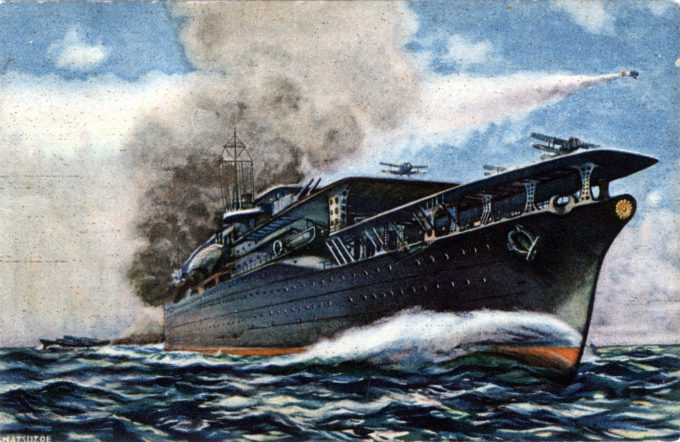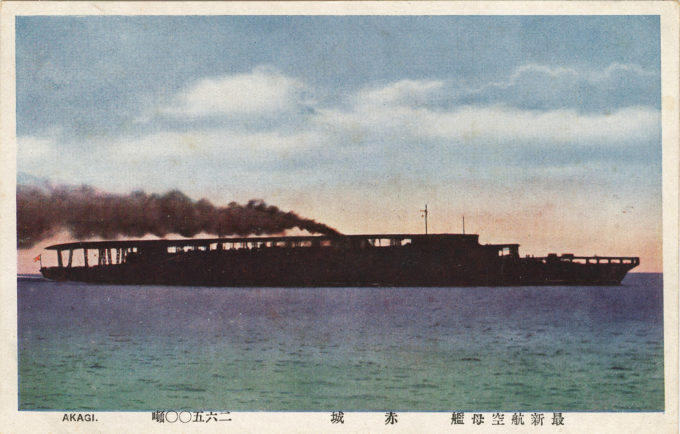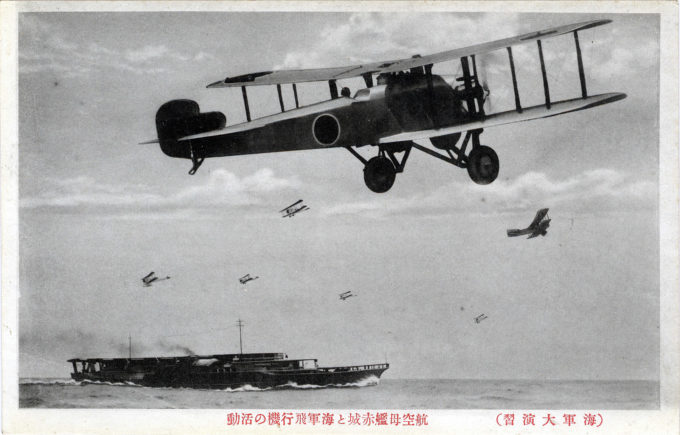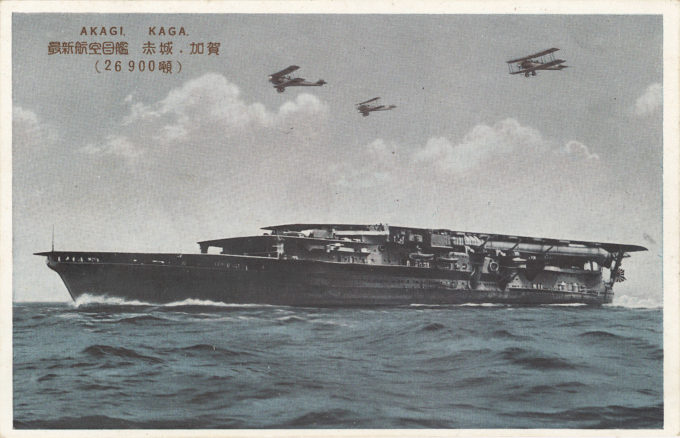
Imperial Japanese Navy aircraft carrier Akagi as originally launched, c. 1930, with her three superimposed flight decks and two starboard funnels. The twin starboard funnels would be replaced during her 1934-35 modernization by a single funnel modeled on that used by the Kaga. Nakajima A1N carrier fighters are taking to the air from the Akagi flight decks.
See also:
Mitsubishi 2MR4 (Type 10) Carrier Reconnaissance biplane, c. 1930.
“Akagi was an aircraft carrier built for the Imperial Japanese Navy (IJN), named after Mount Akagi in present-day Gunma Prefecture.
“Though she was laid down as an Amagi-class battlecruiser, Akagi was converted to an aircraft carrier while still under construction to comply with the terms of the Washington Naval Treaty. Akagi was launched as a carrier on 22 April 1925 and commissioned at Kure Naval Arsenal on 25 March 1927, although trials continued through November 1927. She was the second carrier to enter service with the IJN, after Hōshō and before Kaga.
“Both Akagi and the similarly converted former Tosa-class battleship Kaga were completed with three superimposed flight decks, the only carriers ever to be designed so. The utility of the middle flight deck was questionable as it was so short that only some lightly-loaded aircraft could use it, even in an era when the aircraft were much lighter and smaller than during World War II. As originally completed, Akagi carried an air group of 28 Mitsubishi B1M3 torpedo bombers, 16 Nakajima A1N fighters and 16 Mitsubishi 2MR reconnaissance aircraft.
“Akagi joined the Combined Fleet in August 1927 and was assigned to the First Carrier Division upon its formation on 1 April 1928, serving as the division’s flagship under Rear Admiral Sankichi Takahashi. The carrier’s early career was uneventful, consisting of various training exercises. From 10 December 1928 to 1 November 1929, the ship was captained by Yamamoto Isoroku, future commander of the Combined Fleet. On 15 November 1935, Akagi was placed in third-class reserve to begin an extensive modernization at Sasebo Naval Arsenal.
“Akagi‘s modernization involved far less work than that of Kaga, but took three times as long due to financial difficulties related to the Great Depression. The ship’s three flight decks were judged too small to handle the larger and heavier aircraft then coming into service. As a result, the middle and lower flight decks were eliminated in favor of two enclosed hangar decks that extended almost the full length of the ship. The upper flight deck was extended to the bow, increasing its length to over 800-feet, and raising aircraft capacity to 86 (61 operational and 25 in storage).
“Commanded by Captain Kiichi Hasegawa, Akagi was Vice Admiral Chūichi Nagumo’s flagship for the striking force for the attack on Pearl Harbor in December 1941. In January 1942, together with the rest of the First and Fifth Carrier Divisions, Akagi supported the invasion of Rabaul in the Bismarck Archipelago. On 7 February Akagi and the carriers of the First and Second Carrier Divisions were ordered south to the Timor Sea where, on 19 February, they launched air strikes against Darwin, Australia, in an attempt to destroy its port and airfield facilities to prevent any interference with the invasion of Java.
“On 26 March, Akagi set sail for the Indian Ocean raid with the rest of the Kido Butai [First Air Fleet]. The Japanese intent was to defeat the British Eastern Fleet and destroy British airpower in the region in order to secure the flank of their operations in Burma. On 5 April 1942, 17 D3As from Akagi helped to sink the British heavy cruisers Cornwall and Dorsetshire. Meanwhile, a floatplane from the battleship Haruna spotted the small aircraft carrier Hermes, escorted by the Australian destroyer Vampire, and every available D3A was launched to attack the ships. Akagi contributed 17 dive bombers and they helped to sink both ships.
“Akagi set out on 25 May 1942 with the Combined Fleet’s carrier striking force for the attack on Midway Island in the company of carriers Kaga, Hiryū, and Sōryū. Once again, Nagumo flew his flag on Akagi. After bombarding American forces on the atoll, Akagi and the other carriers were attacked by aircraft from Midway and the carriers Enterprise, Hornet, and Yorktown. Dive bombers from Enterprise severely damaged Akagi. When it became obvious she could not be saved, she was scuttled by Japanese destroyers to prevent her from falling into enemy hands.
“The loss of Akagi and three other IJN carriers at Midway was a crucial strategic defeat for Japan and contributed significantly to the Allies’ ultimate victory in the Pacific.”
– Wikipedia

Imperial Japanese Navy aircraft carrier “Akagi” in silhouette profile, c. 1935, providing a more clear representation of its battlecruiser origin. Note the smoke from the single port-side funnel.
- “Akagi”-class aircraft carrier & Nakajima A1N carrier fighters, c. 1935.
- “Akagi”-class aircraft carrier & Nakajima A1N carrier fighters, Imperial Japanese Navy, c. 1935.



